

By Lora Koenig
McMurdo Station (Antarctica), 15 December — Today the Traverse Team traveled from SEAT Camp 2 to SEAT Camp 3. They picked up their fuel cache at Camp 3 and enjoyed the chocolate chip cookies that were inside. So far, the team has drilled three ice cores and traveled over 220 kilometers (136.7 mi). They will be at Camp 3 for at least two days to drill two ice cores in this area, which is the highest accumulation site on the traverse. The accumulation here will be close to 1 meter (3.28 feet) per year, while at Byrd is was over10 centimeters (3.9 inches) per year. The team is traveling fast and making up lost time each day.
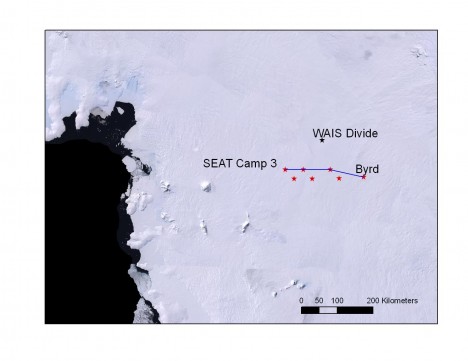
I am in McMurdo, waiting for a plane to fly back to Christchurch, New Zealand. The plane will arrive shortly after 4 AM. The C-17 planes have to land in the middle of the night because the days are already too warm, and the ice on the runway too soft, for a plane to land during daylight. So they are landing in the wee hours of the morning, which corresponds to the coldest part of the day and the hardest ice conditions. Once I get on a plane, I will be in transit for 60 hours, until I reach my home in Maryland.
I will leave Antarctica on the same plane than the Prime Minister of Norway, who was just at the South Pole to celebrate the 100th Anniversary of Ronald Amundsen being the first man to reach the South Pole. Our traverse team is still following in Amundsen’s footsteps, traveling over the ice to gain a better understanding of Antarctica.
By Lora Koenig
Byrd Station (Antarctica), 13 December — Well, I am still at Byrd Camp. One plane for the day from McMurdo has already been canceled and two more are scheduled. Byrd has not had a flight in over a week, and they are trying to get as many flights from McMurdo in as they can. There are still science teams waiting to get here. Also, the camp would like some freshies (fruits and vegetables), to increase moral. I shoveled some more today for the camp and did some house mouse choirs, which included doing the dishes, sweeping, and washing the tables. I may as well stay busy while I am waiting.
The team is traversing to Camp 2 today. They finished the ice core at Camp 1 and all the science is going well. When I last spoke with them, they were going out to locate their fuel cache, so they will have a nice loaf of bread to have with dinner tonight.
I just heard that my plane is in route, so I just may get to McMurdo tonight.
By Lora Koenig
Byrd Station (Antarctica), 12 December —The traverse team left yesterday and made it to Camp 1, 95 kilometers (59 miles) away. I spoke with Michelle last night; they had a few problems yesterday. One was that some bolts on the bottom of the radar sled came loose and the sled started to detach from one of the snowboards that serves as the sled runner. Ludo saw this early in the traverse (3 km, or 1.8 mi, out) and he and Clem fixed the sled with the spare parts kit. They used up all of the spare bolts to fix it. Last night, Michelle and Randy relayed the specifics of the bolts to me and I asked the Byrd mechanic, Paul, if he had any bolts to spare. He did. I added the bolts to the cache list.
The radar team had one additional problem. At some point, with all of the bumping of the sled, the GPS became unplugged. Without the GPS running we cannot tell where the radar data was taken. Ludo and Clem figured out that they had lost about 25 km (15.5 mi) of data. So they turned around, went back and recollected the data. They drove over 140 km (87 mi) yesterday! A huge day. Spirits were high and all was well at SEAT Camp 1 last night.
This morning I woke up at Byrd to patches of blue skies. The pilots told me that we would put in the caches if the weather was good enough for flying, so I jumped out of my sleeping bag ready to go. Also, if the weather held, I would catch a late night flight out of Byrd to McMurdo. I quickly packed my sleep kit and duffle so I would be ready to leave if a plane came. I went to the communications tent to talk with the pilots. At 7 AM they were already loading our 55-gallon drums of fuel in the DC-3 Bassler plane, so I knew we were going to try and put in the caches.
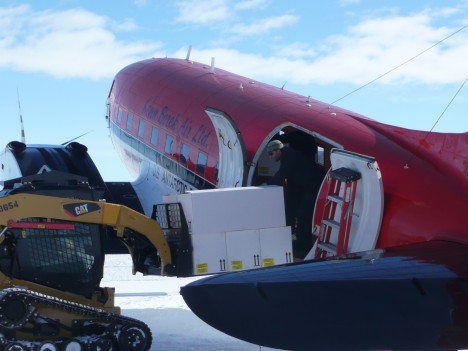
I made a quick stop in the galley on the way to the plane to see if they had any treats I could add to the caches. They gave me a loaf of bread and some home-baked chocolate chip cookies that I tucked into my backpack along with some Snickers bars, teas and letters for the team.
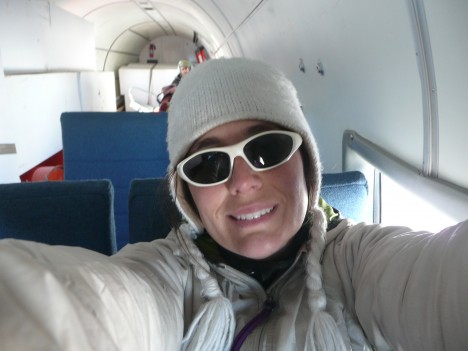
The Bassler took off just before 8 AM. At 8:15 we flew over the traverse team at SEAT Camp 1. I was up in the cockpit so I could see better. Everyone —Michelle, Jessica, Randy, Clem and Ludo— came out of the tents to wave at the plane and the copilot, who was flying the plane at the time, dipped a wing to wave hello. About 15 minutes later, the pilots started looking for a site to land and drop the first cache. The original GPS location did not have good surface definition so we landed about2 km (1.2 mi) away from the planned camp site. I left the bolts, bread, a note and an ice core box for the team.
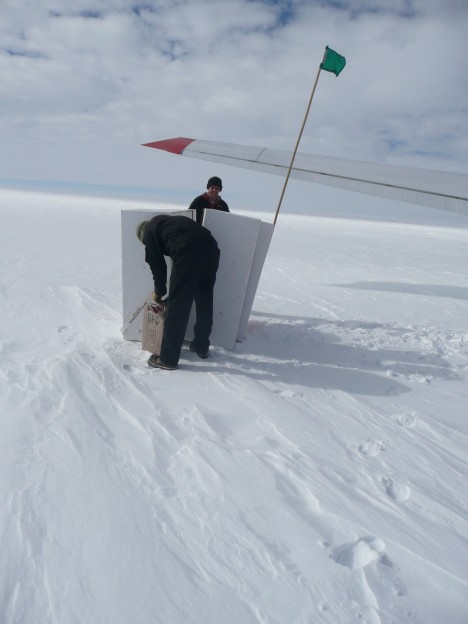
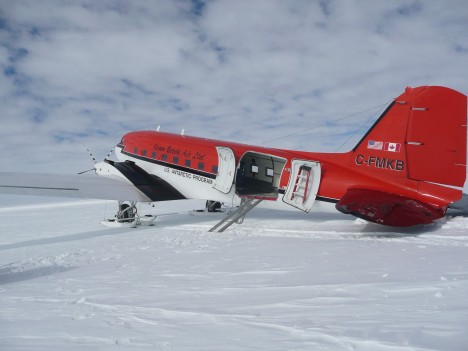
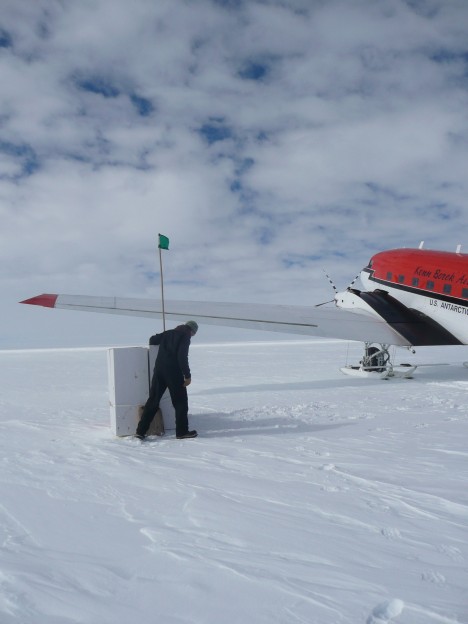
We continued to take off and land at each of the five cache sites. We were able to land exactly at the location of three of the five cache site and at two of the sites the team will have to snowmobile out to retrieve the caches. The caching went fast and took just over 2 hours. At each site, the team will get more premix and mogas, ice core boxes, and a surprise: At the first site, bread; at the second, cookies; at the third, crackers and stickers; at the forth Snickers bars and a Christmas card; and at the fifth, hot chocolate and tea. I told Michelle that I had left a letter at each site but they have no idea that they have gifts too. I hope they enjoy their surprises.
Along the route, I watched the surface carefully. I was looking for sastrugi (wind-blown snow dunes) that could slow the team’s progress, as well as for crevasses. We had already looked at the satellite imagery for crevasses, but it is always good to look with your own eyes. The surface conditions over the route were very smooth (though that could change with a big storm), and there were no crevasses.
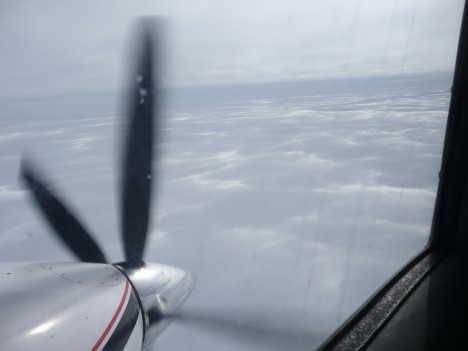
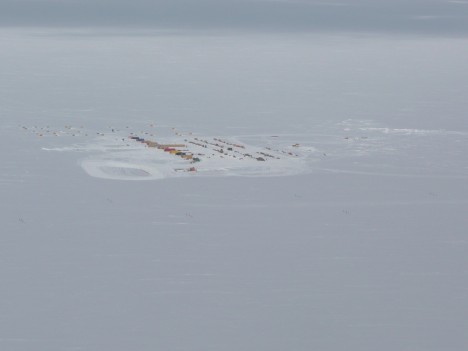
When we returned to Byrd, I needed to relay the cache positions to the team. I called Mac Ops (McMurdo Operations), where the team checks in everyday. Michelle knew to check-in in the evening to get the cache coordinates. I gave Mac Ops the cache locations and left a message for Michelle to call Byrd Camp for more information on the route conditions. Since I was expecting to get a flight out that afternoon I left detailed notes with the Byrd Camp manager, Kaija.
In the early afternoon, a fog bank came in over Byrd Camp and I knew I would not be leaving today. I spent the afternoon digging out fuel bladder to help contribute to camp choirs. There is always a lot of work to be done at field camps. At 9 PM I answered the call from Michelle to Byrd Camp. She was surprised to hear my voice. I told her about the route and she told me they had completed drilling the ice core at Camp 1. They plan on traveling to Camp 2 tomorrow. Great progress! The team is happy and excited to be making such good time. We are all happy that the caches are in so they can complete their work without worrying about getting good enough weather for a plane to fly.

I am now just waiting for a plane to arrive so I can get home. I am over a week delayed getting back. The good thing is that the traverse team has made up time at both Byrd and Camp 1 and are almost back on schedule after the delays in McMurdo.
Other news from Byrd Camp is that the camp population was very small last night. After the Bassler cached our supplies it took off to fly for Polenet, another science team at Byrd putting out seismometers and GPS stations. The Bassler could not return to Byrd due to fog that rolled in, and it had to divert to WAIS Divide camp, so about eight people are staying there for the night.
Here’s hoping for better weather tomorrow though the forecast does not look good.
By Lora Koenig
Byrd Station (Antarctica), 11 December — We all got up at 5 AM this morning. I had gone to bed at 2 am because I had been backing up all of the radar data, which took much longer than anticipated. The traverse team went to bed early to be rested for the day.
It was a beautiful morning: warm, no wind, with thin, low, overcast clouds. The sleds were loaded and ready to go, already hooked on to the snowmobiles. Ludo was the first to the sleds and he started the generator, which powers heating pads that are used to warm the radars after being cold soaked all night. After about 15 minutes of warming, the radars can be started. During this time, the GPS is also turned on so it can obtain lock with the satellites and provide accurate positions.
I took the snowmobile covers off and helped Michelle load the final sleep kits on the sleds. The sleep kits are the last things to be loaded and contain a sleeping bag, sleeping bag liner, insolite pad, thermorest, pillow (if you want one, though most of us prefer to just use big red as a pillow), and a pee bottle so you don’t have to leave the tent in the middle of a cold night or storm. All of this is stuffed into a duffle bag and goes with you everywhere inAntarctica.
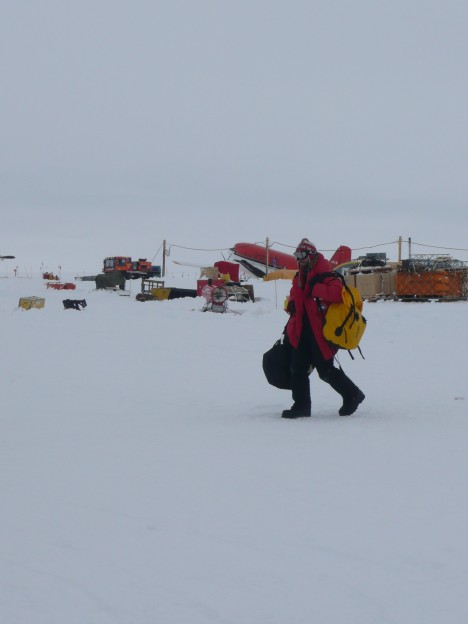
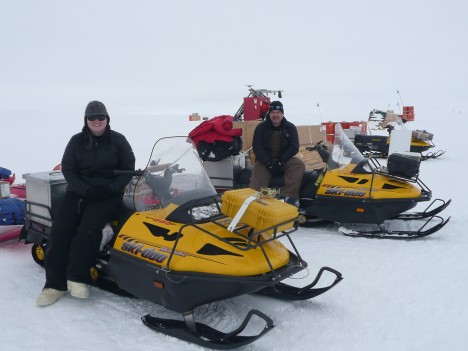
Once the generator was started, the team headed into the galley for a quick breakfast. Most of the camp was still asleep because Sunday is their day off; however, Kaija and Tony, the camp manager and assistant manager, came up to see the team off. After breakfast, the radars were turned on and the snowmobiles started. We took some final pictures and I tried to shoot some video but the small video camera we brought along is not operating well in the cold. The feeling of both excitement and nervousness was in the air. Excitement for finally getting to the traverse portion of the science and nervousness because the team is headed out into the remoteness ofAntarcticaalone. They will no longer have the security of an established camp and will have to rely on each other for everything. The team is strong and I know they will do well. During the traverse they will most certainly cover ground that no human has ever walked on before.
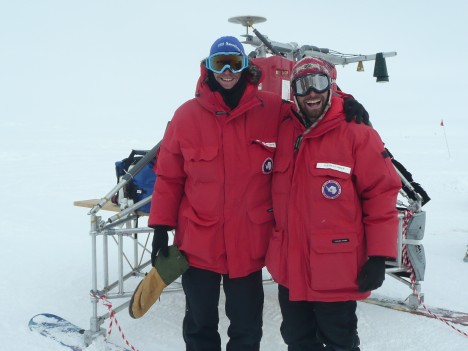
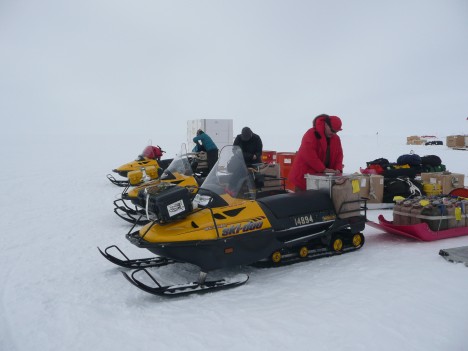
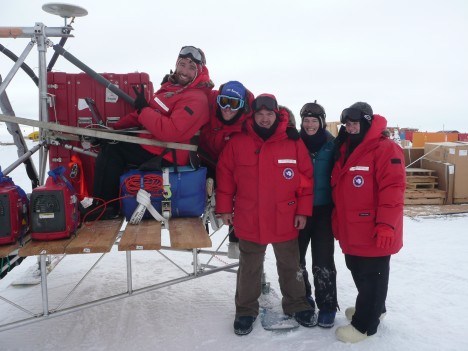
At 6:41 AM, Michelle led the team out of Byrd Camp. She pulled a Siglin sled and a Nansen sled with food, the Scott tent, an HF radio for emergency communication, the radar spare parts, the sleep kits and personal gear. Michelle rides one of the two snowmobiles with mirrors so she can easily watch the team. Jessica followed pulling 2 Siglin sleds with food, the ice core drill and two ice core boxes. Randy was third in line with two Siglin sleds with even more food, the mountain tents, emergency bag, and all of the fuel. Ludo pulled the final snowmobile out and into line pulling the radar sled with Clem on the sled operating the radar. We all screamed and waved as they pulled away.
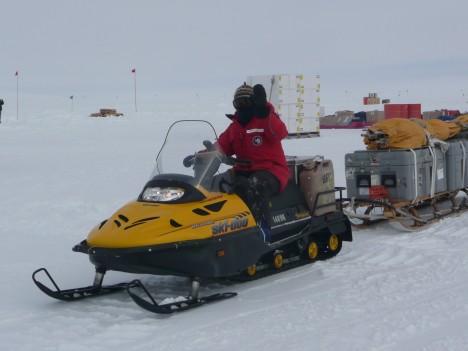
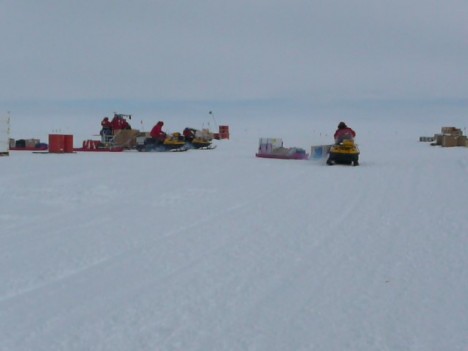

I continued to watch as they moved further towards the horizon. They became smaller and smaller dots on the horizon above tent city as they moved away from camp. At 7:12 AM their dots blurred into the horizon. The traverse had begun.

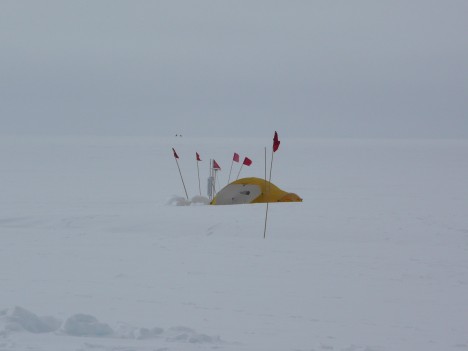
They will travel 95 km (59 mi) today, their longest stretch of the entire traverse, to the first camp site. They are moving toward higher snow accumulation and towards WAIS Divide field camp. When they reach the site tonight, they will be95 km(59 mi) from Byrd and85 km(52.8 mi) from WAIS Divide, so if they have any problems they will head to WAIS Divide, not Byrd.
I am feeling very lonely sitting in Byrd camp without the team, but there is still important work to do. Remember, the team still does not have their fuel caches. The pilots are in camp, but today’s overcast weather, while great for traversing, is not adequate for flying: The clouds make it difficult to see the snow surface. The pilots call this surface definition. In order to do open field landings (landings not on a ski way), the pilots cannot have overcast clouds at any level. Now I am just waiting for the weather to clear so that the plane can cache the team’s fuel and ice core boxes. I am also waiting for an LC-130 to come into Byrd so I can get a ride back to McMurdo and then back to the U.S.
Today I will also check the base station GPS and give a science lecture about our traverse to the Byrd Camp residents.
Everyone at Byrd Camp has helped us so we can complete our science goals and it is much appreciated. Thank you, Byrd Camp! We especially enjoyed the wonderful food made by Chef Rob. The team’s send-off dinner was duck with a port sauce, chicken with polenta, pureed carrots, broccoli with hollandaise sauce, and Boston Cream and Lemon Meringue pie for dessert. Yummmmm!
Around 7 PM tonight I expect to get a satellite phone call from Michelle. From this point on, the blog will have less pictures for a while because we will only have voice communication with the team. It should take between 24 and 30 days to complete the traverse, including (bad) weather days. The team will communicate back to me at each camp site and I will update you on their progress. When they return, we will post more posts from them with pictures of the traverse.
The team is truly out in the wilderness. The only communication they have is through the sat phone, which will only be on for a few hours in the evening. They can call their families and their families can send 160 character text messages to the sat phone. The deep field ofAntarcticais a remote place.
Go team, go!!!!!! (The extra exclamation points are for Clem, who loves to use them.)
Today, Clem and Ludo did a little science. They dragged the radar in a grid pattern around the ice core site from yesterday. This is important data because it tells us how representative the point where the ice core was drilled is of the larger area around it. When we compare ice core data to satellite data, we want to know if the larger area is homogeneous (similar) or not.
Randy made sure all the snowmobiles were ready and fueled to leave early in the morning. One of the choke leavers on a snowmobile broke off so he was working with the mechanic to get it fixed. Jessica looked at the electrical conductivity measurements from yesterday and took pictures of all of the log book pages to create a back up of the data. Michelle spent the day making sure all the gear was loaded well on the sled and that nothing was missing.
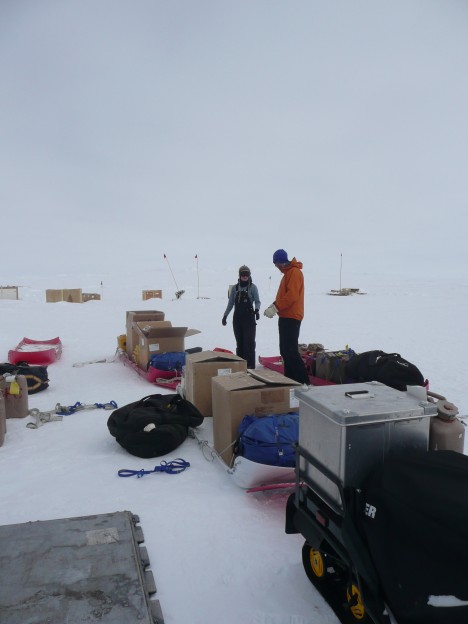
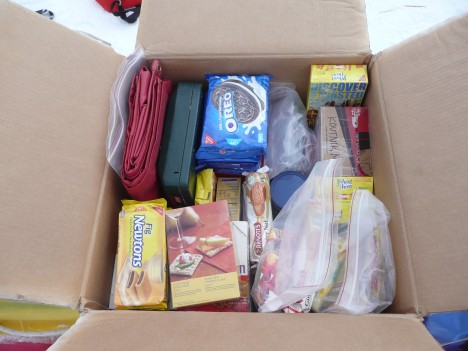
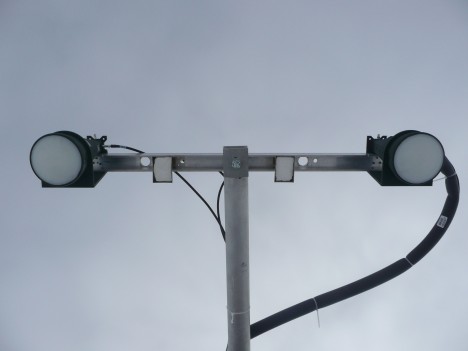
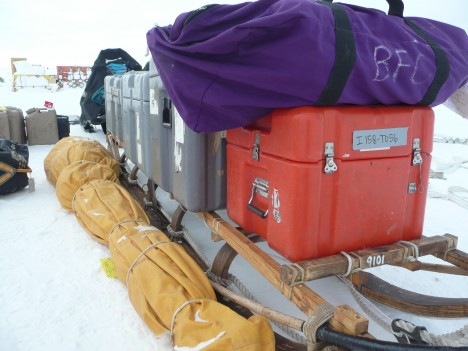
I spent most of the day watching the weather and talking with pilots. We cannot carry all of our gear on the sleds. A DC-3 Bassler aircraft is supposed to drop our fuel and ice core boxes and each camp site before the traverse. Due to the bad weather, the fuel cache has not yet been cached. So I have been talking with the pilots and rearranging the caches so the team can start out and not incur more delays. For now, the team will leave in the morning carrying two ice core boxes and one 55-gallon drum of fuel. This will allow them to get to the first camp site and drill. It will also give them enough fuel to get back to an established field camp if for some reason they don’t get any more fuel. They will not go to Camp 2 until they know the cache of fuel is there. Hopefully the cache will occur tomorrow or the next day so the traverse team will not be delayed.
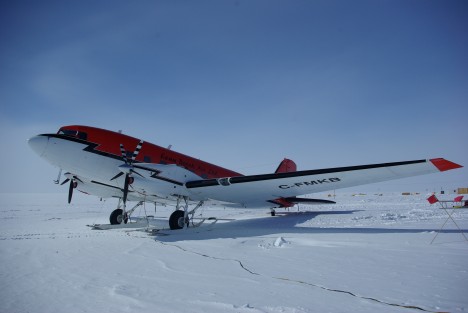
Everyone will go to sleep early tonight. Because all of Antarctica operates on McMurdo time, the time of the day at Byrd does not match the daily temperature changes. The coldest part of the day, which would generally fall from 1 to 4 AM, is usually between 6 and 10 PM our time. The warmest time falls in the morning between 6 and 10 AM. Tomorrow the team will get up at 5 AM and leave around 6 AM to take advantage of the warmest part of the day. By 6 PM they hope to be cooking dinner and in their warm tents.